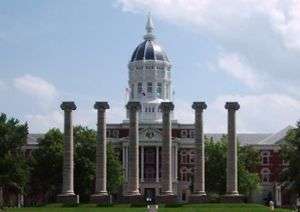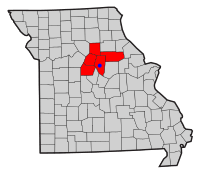Columbia metropolitan area (Missouri)
The Columbia metropolitan area is the region centered around the City of Columbia in the U.S. state of Missouri. Located in Mid-Missouri, it consists of five counties: Boone, Audrain, Randolph, Cooper, and Howard.[2] The population was estimated at 256,640 in 2017, making it the 4th largest metropolitan area in Missouri. Columbia is home to the University of Missouri, and is Missouri's fourth most-populous and fastest growing city, with an estimated 121,717 residents as of 2017.[3][4] Other significant cities in the area include Moberly, Mexico, Boonville, Vandalia, Centralia, and Fayette.
Columbia, Missouri Metropolitan Area Columbia-Moberly-Mexico, MO CSA | |
|---|---|
 Jesse Hall at the University of Missouri | |
 Location in Missouri 38.951561°N 92.328638°W | |
| Country | |
| State | |
| Largest city | |
| Other cities | |
| Counties | |
| Population (2017)[1] | |
| • MSA | 206,054 (217th) |
| • CSA | 256,640 (181st) |
| Time zone | UTC−6 (CST) |
| • Summer (DST) | UTC−5 (CDT) |
| Area code(s) | 573 |
The area was originally called the Boonslick and settled mainly by Kentuckians following the Boone's Lick Road starting around 1812.[5] The town of Franklin, now washed into the Missouri River, was an early commercial center and start of the Santa Fe Trail. Columbia was founded as county seat of Boone County in 1821. The region was considered for the location of the Missouri State Capitol, but eventually a site was chosen 30 miles south of Columbia and Jefferson City was created to serve that purpose. Today, Interstate 70, and U.S. Highways 63, 54, 24, and 40 link the urban areas. The U.S. Census defines the Columbia MSA as Boone, Cooper, and Howard counties while the addition of Audrain and Randolph form the combined statistical area.
Counties
Incorporated places
Cities with greater than 100,000 inhabitants
- Columbia (principal city), 123,195
Towns with greater than 1,000 inhabitants
- Boonville, 8,423
- Centralia, 4,136
- Vandalia (partial), 3,899 (~2,000 are inmates at a local prison)
- Ashland, 3,707
- Fayette, 2,695
- Huntsville, 1,564
- Hallsville, 1,491
- Glasgow, 1,096
Towns with greater than 100 inhabitants
- Sturgeon, 872
- Higbee, 568
- Laddonia, 513
- Farber, 322
- Martinsburg, 304
- Clark, 298
- Cairo, 292
- Harrisburg, 266
- Rocheport, 239
- Renick, 172
- Rush Hill, 151
- Jacksonville, 151
- Clifton Hill, 114
- Benton City, 104
- Hartsburg, 103
Unincorporated places
Demographics
As of the census[6] of 2000, there were 145,666 people, 56,930 households, and 34,010 families residing within the MSA. The racial makeup of the MSA was 85.83% White, 8.42% African American, 0.41% Native American, 2.76% Asian, 0.03% Pacific Islander, 0.67% from other races, and 1.87% from two or more races. Hispanic or Latino of any race were 1.72% of the population.
The median income for a household in the MSA was $34,550, and the median income for a family was $45,689. Males had a median income of $29,837 versus $22,970 for females. The per capita income for the MSA was $17,521.
See also
- Missouri census statistical areas
- List of cities in Missouri
- List of villages in Missouri
References
- "U.S. Census website". Retrieved December 2, 2018.
- "OMB Bulletin No. 18-04: Update of Statistical Area Definitions and Guidance on Their Uses" (PDF). United States Office of Management and Budget. September 14, 2018. Retrieved March 3, 2019.
- "Is your city's population keeping pace? The fastest-growing city in each state". USA TODAY.
- "U.S. Census Bureau QuickFacts: Columbia city, Missouri". Census Gov.
- Switzler, William F. (1882). History of Boone County. St. Louis: Western Historical Company.
- "U.S. Census website". United States Census Bureau. Retrieved 2008-01-31.


